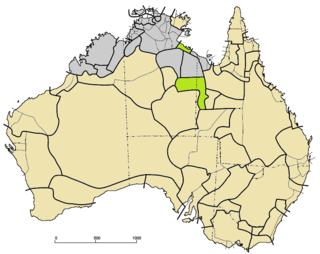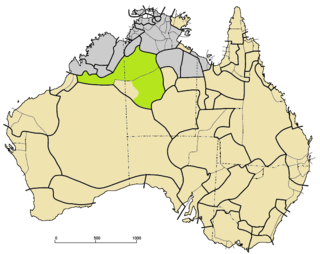Related Research Articles

The Indigenous languages of Australia number in the hundreds, the precise number being quite uncertain, although there is a range of estimates from a minimum of around 250 up to possibly 363. The Indigenous languages of Australia comprise numerous language families and isolates, perhaps as many as 13, spoken by the Indigenous peoples of mainland Australia and a few nearby islands. The relationships between the language families are not clear at present although there are proposals to link some into larger groupings. Despite this uncertainty, the Indigenous Australian languages are collectively covered by the technical term "Australian languages", or the "Australian family".

The Ngarrkic (Ngarga) or Yapa languages are a small language family of Central Australia, consisting of the two closely related languages Warlmanpa and the more populous Warlpiri.

Giimbiyu is an extinct Aboriginal Australian language isolate once spoken by the Giimbiyu people of northern Australia.

The Ngarinyin language, also known as Ungarinjin and Eastern Worrorran, is an endangered Australian Aboriginal language of the Kimberley region of Western Australia spoken by the Ngarinyin people.

Yarli (Yardli) was a dialect cluster of Australian Aboriginal languages spoken in northwestern New South Wales and into Northeastern South Australia individually Malyangapa (Maljangapa), Yardliyawara, and Wadikali. Bowern (2002) notes Karenggapa as part of the area, but there is little data.

The Paman languages are an Australian language family spoken on Cape York Peninsula, Queensland. First noted by Kenneth Hale, Paman is noteworthy for the profound phonological changes which have affected some of its descendants.

The Ngarna or Warluwar(r)ic languages are a discontinuous primary branch of the Pama–Nyungan language family of Australia. The moribund Yanyuwa language is the only survivor of this group.

The Paakantyi language, also spelt Paakantji, Barkindji, Barkandji, and Baagandji, and also known as the Darling language, is a nearly extinct Australian Aboriginal language spoken along the Darling River in New South Wales from present-day Bourke to Wentworth and including much of the back country around the Paroo River and Broken Hill. The people's and language name refers to the Paaka with the suffix -ntyi meaning "belonging to". The speakers of the language are known as the Paakantyi.

The Gangulu people, also written Kangulu, Kaangooloo, Ghungalu and other variations, are an Aboriginal Australian people from the Mount Morgan area in Queensland, Australia.

Worrorra, also written Worora and other variants, and also known as Western Worrorran, is a moribund Australian Aboriginal language of northern Western Australia. It encompasses a number of dialects, which are spoken by a group of people known as the Worrorra people.

Maran or Maric is an extinct branch of the Pama–Nyungan family of Australian languages formerly spoken throughout much of Queensland by many of the Murri peoples. The well attested Maric languages are clearly related; however, many languages of the area became extinct before much could be documented of them, and their classification is uncertain. The clear Maric languages are:
Kukatj, also rendered Gugadj, is an extinct Paman language of the Cape York Peninsula, Queensland, Australia. The name Kalibamu has also been assigned to it, although this may be a separate dialect. It is spoken by the Kukatj people. A single speaker was last recorded in 1975.
Wagaya (Wakaya) is an extinct Australian Aboriginal language of Queensland. Yindjilandji (Indjilandji) may have been a separate language. The linguist Gavan Breen recorded two dialects of the language, an Eastern and a Western variety, incorporating their description in his 1974 grammar.
Wanggamala, also spelt Wanggamanha, Wangkamahdla, Wangkamadla, Wangkamanha, Wangkamana, Wonkamala, Wongkamala, Wonkamudla, and other variants, is an extinct Australian Aboriginal language of the Pama–Nyungan family, previously spoken in the Northern Territory around Hay River and to the south of the Andegerebinha-speaking area.

The Ngumpin–Yapa a.k.a. Ngarrka–Ngumpin languages are a family of Pama–Nyungan languages of the Pilbara region of Australia.

The Garawan languages (Garrwan), or Yanyi, are a small language family of Australian Aboriginal languages currently spoken in northern Australia.
Little Swanport Tasmanian is an aboriginal language of Tasmania in the reconstruction of Claire Bowern. It was spoken near the modern town of Little Swanport on the east coast. Dixon & Crowley had noted that it appeared to be distinct, but were not sure if it constituted a separate language from other word lists collected near Oyster Bay.
The Kukatja people, also written Gugadja, are an Aboriginal Australian people of the Kimberley region of Western Australia.
The Ngardi, also spelled Ngarti, are an Aboriginal Australian people of the Northern Territory and Western Australia.
The Yangkaal, also spelt Yanggal, are an Aboriginal Australian people of area of the Gulf of Carpentaria in the state of Queensland.
References
- 1 2 A121 Ngardi at the Australian Indigenous Languages Database, Australian Institute of Aboriginal and Torres Strait Islander Studies
- ↑ Bowern, Claire. 2011 "How Many Languages Were Spoken in Australia?", Anggarrgoon: Australian languages on the web, December 23, 2011 (corrected February 6, 2012)
- ↑ A121 Ngardi at the Australian Indigenous Languages Database, Australian Institute of Aboriginal and Torres Strait Islander Studies
- ↑ A69 Bunara at the Australian Indigenous Languages Database, Australian Institute of Aboriginal and Torres Strait Islander Studies
- ↑ A63 Waringari at the Australian Indigenous Languages Database, Australian Institute of Aboriginal and Torres Strait Islander Studies
- ↑ Tindale 1974, p. 234.
- ↑ Tindale 1974, p. 243.
- ↑ Tindale 1974, p. 255.
- ↑ Tindale 1974, p. 237.
Sources
- Capell, A. (1962). Some linguistic types in Australia. Sydney: Oceania Publications.
- Dixon, R. M. W. (2002). Australian Languages: Their Nature and Development. Cambridge: Cambridge University Press.
- Honeyman, Tom (2005). Topic and Focus in Ngardi. thesis. University of Sydney.
- McConvell and Laughren (2004) "The Ngumpin-Yapa subgroup". In Claire Bowern & Harold Koch, Australian Languages: Classification and the Comparative Method. Amsterdam/Philadelphia: John Benjamins Publishing Company.
- Tindale, Norman Barnett (1974). "Ngardi (NT)". Aboriginal Tribes of Australia: Their Terrain, Environmental Controls, Distribution, Limits, and Proper Names. Australian National University Press. ISBN 978-0-708-10741-6.